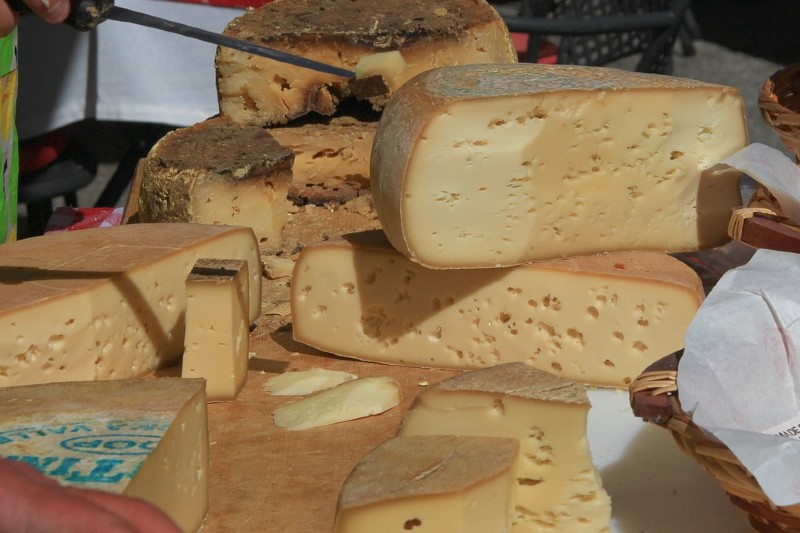What Does Asiago Cheese Taste Like?
Quick Answer
Asiago cheese varies in flavor depending on its age. Fresh Asiago is soft and has a mild, buttery taste, often used in sandwiches and salads. In contrast, mature Asiago is hard and crumbly, with a sharp, nutty flavor, commonly grated over pasta dishes or enjoyed as a table cheese. Overall, Asiago can range from sweet and mild to sharp and complex.
What is Asiago Cheese?
Asiago cheese is an Italian cow’s milk cheese that originates from the Asiago Plateau in the Veneto foothills of Italy.
It comes in two main varieties: fresh Asiago (Asiago Pressato), which is soft and mild, and mature Asiago (Asiago d’allevo), which is hard and has a more robust, nutty flavor.
Asiago Pressato (Fresh) vs Asiago d’Allevo (Aged)
| Characteristics | Asiago Pressato (Fresh) | Asiago d’Allevo (Aged) |
|---|---|---|
| Age | 20 to 40 days | 2 months to over a year |
| Texture | Soft and creamy | Crumbly to grainy |
| Color | Pale yellow/white | Straw to deep yellow |
| Aroma | Mild, slightly sweet | Pungent, intense |
| Taste | Mild, buttery, slightly sweet | Robust, nutty, tangy |
| Flavor Complexity | Less complex, straightforward | More complex, layered |
| Culinary Uses | Sandwiches, salads, sauces | Grating, pasta, risottos |
| Common Pairings | White wines, mild fruits | Bold red wines, figs, grapes |
The cheese is versatile and can be used in a variety of dishes, from salads and sandwiches to pasta and risottos.
What Does Asiago Cheese Taste Like?
Asiago cheese is popular for its unique flavor profile, which can vary significantly depending on whether it is fresh or aged. The cheese provides a complex symphony of tastes, textures, and aromas that make it a versatile choice in a wide variety of dishes. Here’s a breakdown of the basic flavor profile of Asiago cheese:
- Nutty: Asiago cheese, particularly when aged, has a distinct nutty flavor that gives it depth and complexity. This characteristic makes it excellent for adding dimension to various dishes, from pasta to risottos and even salads.
- Tangy: The tangy notes are more pronounced in Asiago d’Allevo, the aged variant. This tanginess adds an extra kick that contrasts nicely with the cheese’s nutty aspects, making it perfect for adding a touch of excitement to dishes or when enjoyed alone.
- Buttery: Asiago Pressato, the fresher type of Asiago, tends to be buttery and slightly sweet. This butteriness is softer on the palate, and it pairs well with milder flavors like fruits and white wines. The buttery quality also makes it an ideal cheese for melting.
What is the Texture of Asiago Cheese?
- Crumbly: Aged Asiago, or Asiago d’Allevo, tends to have a crumbly texture, especially when aged for longer periods. This texture makes it suitable for grating over dishes or enjoying in small, crumbly bites.
- Creamy: Fresh Asiago, or Asiago Pressato, has a softer, more creamy texture that makes it more spreadable. It’s excellent in sandwiches, melts well, and can even be used as a dip when blended with other ingredients.
Smell
- Mild: Fresh Asiago offers a mild, almost sweet aroma that is inviting but not overpowering. This makes it a good choice for those who prefer less intense cheese aromas.
- Pungent: Aged Asiago’s smell grows more intense and pungent as it ages. The aroma is rich and complex, complementing its robust flavor. It’s the sort of smell that cheese enthusiasts often adore, and it pairs well with equally strong flavors like bold wines and cured meats.
Comparing Asiago to Other Cheeses: Parmesan, Pecorino, and Gouda
| Characteristics | Asiago | Parmesan | Pecorino | Gouda |
|---|---|---|---|---|
| Origin | Italy | Italy | Italy | Netherlands |
| Milk Type | Cow’s Milk | Cow’s Milk | Sheep’s Milk | Cow’s Milk |
| Taste | Nutty, tangy, buttery | Salty, nutty, slightly fruity | Salty, tangy, gamey | Sweet, caramel-like, nutty |
| Texture | Crumbly to creamy (age-dependent) | Hard, crumbly | Firm to hard | Smooth to crumbly (age-dependent) |
| Aroma | Mild to pungent (age-dependent) | Strong, pungent | Strong, gamey | Mild to caramel-like (age-dependent) |
| Aging | 20 days to over a year | Generally over a year | Varies, often over a year | Few weeks to several years |
| Culinary Uses | Grating, melting, salads | Grating, risottos, pasta | Grating, pasta, charcuterie | Cheese boards, melting, sandwiches |
| Common Pairings | Wine, fruits, pasta | Red wine, fruits, nuts | Bold wines, olives, cured meats | Beer, fruits, crusty bread |
FAQs
Is Asiago Cheese Similar To Parmesan?
While both cheeses are Italian and often used for grating, Asiago is generally milder and can range from soft to hard depending on its age. Parmesan is usually harder, saltier, and aged for a longer period.
How Does Asiago Differ From Pecorino?
Pecorino is made from sheep’s milk and tends to have a saltier, tangier, and sometimes gamey flavor. Asiago is made from cow’s milk and is generally nuttier and milder.
Can I Use Asiago Cheese As A Substitute For Other Cheeses?
Yes, Asiago can be used as a substitute for Parmesan or Romano in most recipes, although the flavor profile will be slightly different. Fresh Asiago can also replace mild cheeses like mozzarella or provolone in certain dishes.
What Are The Best Pairings For Asiago Cheese?
Fresh Asiago pairs well with light wines and mild fruits, while aged Asiago is excellent with bold red wines, figs, and grapes.
How Is Asiago Used In Cooking?
Fresh Asiago can be used in sandwiches, salads, and sauces, as it melts well. Aged Asiago is more often grated over pasta, risottos, and used in more robust, flavored dishes.
Is Asiago Good For Melting?
Fresh Asiago, known as Asiago Pressato, is excellent for melting due to its softer, creamy texture. Aged Asiago can also melt but will have a different, more crumbly texture.
Is Asiago Cheese Strong?
The strength of Asiago cheese depends on its age. Fresh Asiago has a milder flavor, while aged Asiago has a stronger, more intense taste and aroma.
What Foods Does Asiago Cheese Complement?
Asiago cheese complements a variety of foods. Fresh Asiago works well in sandwiches and salads, while aged Asiago is excellent when grated over pasta, risottos, and even meat dishes.
Does Asiago Taste Like Blue Cheese?
No, Asiago cheese does not taste like blue cheese. While both cheeses are complex and can have tangy flavors, especially when aged, they are fundamentally different.
Asiago is made from cow’s milk and has a nutty, buttery, and tangy profile. Blue cheese, on the other hand, is known for its sharp, pungent, and often peppery flavors, which come from the specific molds used during its aging process.
The taste of blue cheese is much more intense and divisive compared to the milder, more universally pleasing flavors of Asiago.
What Does Asiago Cheese Smell Like?
The smell of Asiago cheese varies depending on its age. Fresh Asiago, or Asiago Pressato, has a mild, almost sweet aroma that is inviting but not overpowering.
Aged Asiago, known as Asiago d’Allevo, develops a richer, more pungent aroma that can be intense but is usually not as strong as the smells associated with blue cheese or other strong cheeses.
Overall, the aroma of Asiago can be described as ranging from mild to rich, complementing its varying flavors.
What Cheese is Closest to Asiago?
Parmesan and Pecorino are often considered the closest relatives to Asiago due to their shared Italian origins and similar applications in cuisine.
Both cheeses are hard and well-suited for grating, although they have their distinct characteristics.
Parmesan is generally harder and saltier, while Pecorino has a tangy, almost gamey flavor due to its sheep’s milk origin. If you are looking for a milder alternative, consider Provolone for its similar texture to fresh Asiago.
Is Asiago Cheese Spicy?
No, Asiago cheese is not spicy. It does have a tangy kick, especially when aged, but it does not contain any spices or ingredients that would make it spicy.
The tanginess is more akin to a zesty or zingy quality rather than spiciness. However, it can be paired with spicy foods or used in spicy recipes to complement those flavors.
Can You Eat The Rind of Asiago Cheese?
The rind of Asiago cheese is generally not eaten, especially when it comes to aged varieties that have a hard, inedible rind.
The rind is usually waxed or naturally hardened during the aging process, making it tough and unpleasant to chew.
However, it can be used to add flavor to soups and stews, much like a Parmesan rind. If you’re working with fresh Asiago, the rind may be softer and technically edible, but it is usually removed for texture and consistency reasons.



